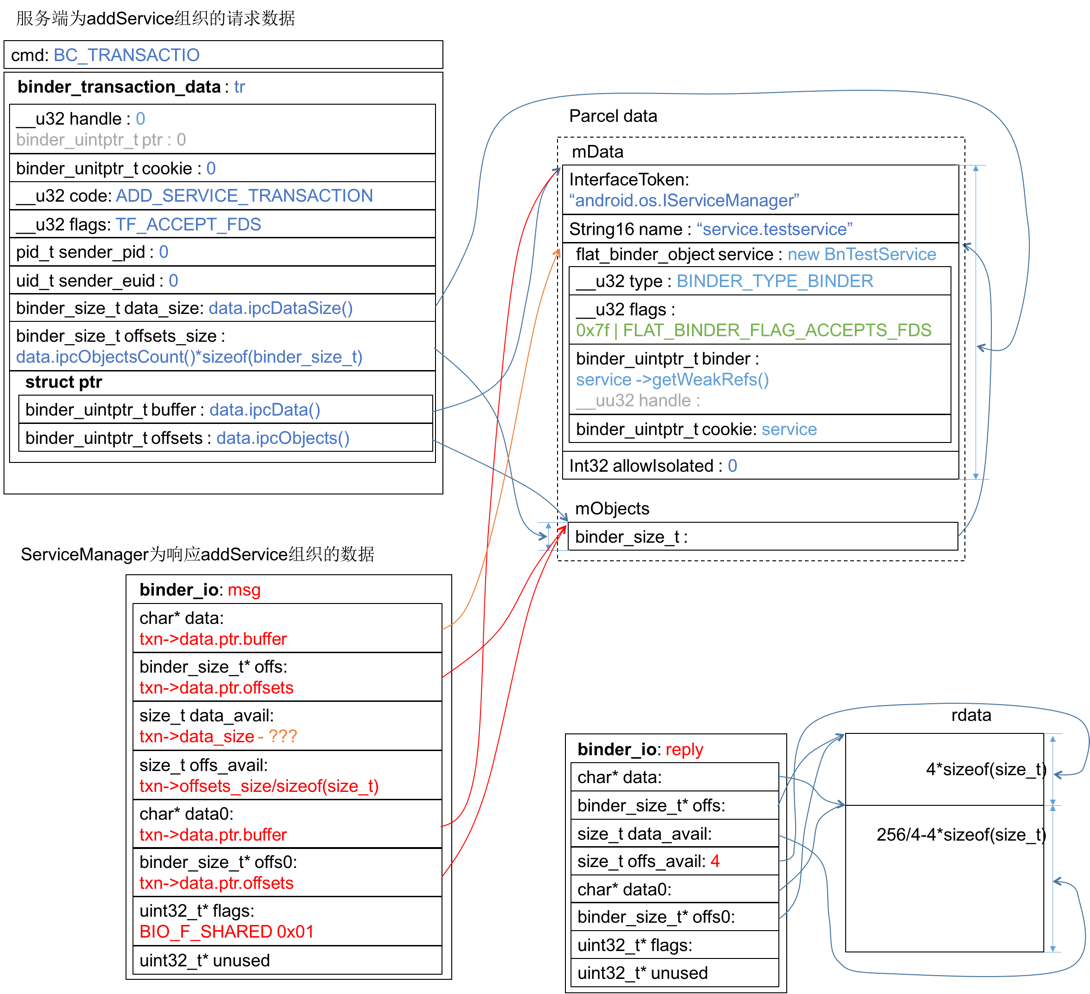Binder学习笔记(七)—— ServiceManager如何响应addService请求
有了《ServiceManager如何响应checkService请求》的探索,研究addService就轻车熟路了,中间过程不再多说,仅把关键节点列出:
frameworks/native/cmds/servicemanager/service_manager.c:347
int main(int argc, char **argv) { …… binder_loop(bs, svcmgr_handler); …… }
frameworks/native/cmds/servicemanager/binder.c:372
void binder_loop(struct binder_state *bs, binder_handler func) { …… for (;;) { …… res = binder_parse(bs, 0, (uintptr_t) readbuf, bwr.read_consumed, func); …… } }
frameworks/native/cmds/servicemanager/binder.c:204
int binder_parse(struct binder_state *bs, struct binder_io *bio, uintptr_t ptr, size_t size, binder_handler func) { …… case BR_TRANSACTION: { struct binder_transaction_data *txn = (struct binder_transaction_data *) ptr; …… if (func) { unsigned rdata[256/4]; struct binder_io msg; struct binder_io reply; int res; bio_init(&reply, rdata, sizeof(rdata), 4); bio_init_from_txn(&msg, txn); res = func(bs, txn, &msg, &reply); binder_send_reply(bs, &reply, txn->data.ptr.buffer, res); } ptr += sizeof(*txn); break; } …… return r; }
此时的内存数据结构为:

frameworks/native/cmds/servicemanager/service_manager.c:244
int svcmgr_handler(struct binder_state *bs, struct binder_transaction_data *txn, struct binder_io *msg, struct binder_io *reply) { struct svcinfo *si; uint16_t *s; size_t len; uint32_t handle; uint32_t strict_policy; int allow_isolated; …… switch(txn->code) { …… case SVC_MGR_ADD_SERVICE: s = bio_get_string16(msg, &len); // "service.testservice" if (s == NULL) { return -1; } handle = bio_get_ref(msg); allow_isolated = bio_get_uint32(msg) ? 1 : 0; // 0 if (do_add_service(bs, s, len, handle, txn->sender_euid, allow_isolated, txn->sender_pid)) return -1; break; …… default: ALOGE("unknown code %d\n", txn->code); return -1; } bio_put_uint32(reply, 0); return 0; }
SVC_MGR_ADD_SERVICE分之内从msg读出的数据对照“服务端为addService组织的请求数据”示意图很容易拆解出来,需要看一下bio_get_ref(…),frameworks/native/cmds/servicemanager/binder.c:627
uint32_t bio_get_ref(struct binder_io *bio) { struct flat_binder_object *obj; obj = _bio_get_obj(bio); if (!obj) return 0; if (obj->type == BINDER_TYPE_HANDLE) return obj->handle; return 0; }
frameworks/native/cmds/servicemanager/binder.c:611
static struct flat_binder_object *_bio_get_obj(struct binder_io *bio) { size_t n; size_t off = bio->data - bio->data0; /* TODO: be smarter about this? */ for (n = 0; n < bio->offs_avail; n++) { if (bio->offs[n] == off) return bio_get(bio, sizeof(struct flat_binder_object)); } bio->data_avail = 0; bio->flags |= BIO_F_OVERFLOW; return NULL; }
经过前面几条bio_get_xxx,msg的data指针已经挪到了flat_binder_object实体处,如下图所示,橙色箭头表示msg初始化后到执行bio_get_ref(msg)之前,data指针的挪动情况。_bio_get_obj(…)负责将此flat_binder_object实体返回。

frameworks/native/cmds/servicemanager/service_manager.c:194
int do_add_service(struct binder_state *bs, const uint16_t *s, size_t len, uint32_t handle, uid_t uid, int allow_isolated, pid_t spid) { // s="service.testservice", allow_isolated=0, handle=? struct svcinfo *si; …… si = find_svc(s, len); if (si) { if (si->handle) { ALOGE("add_service('%s',%x) uid=%d - ALREADY REGISTERED, OVERRIDE\n", str8(s, len), handle, uid); svcinfo_death(bs, si); } si->handle = handle; } else { // 重点在这里,如果服务没有add过,则为之创建节点,保存名字和handle si = malloc(sizeof(*si) + (len + 1) * sizeof(uint16_t)); if (!si) { ALOGE("add_service('%s',%x) uid=%d - OUT OF MEMORY\n", str8(s, len), handle, uid); return -1; } si->handle = handle; si->len = len; memcpy(si->name, s, (len + 1) * sizeof(uint16_t)); si->name[len] = '\0'; si->death.func = (void*) svcinfo_death; si->death.ptr = si; si->allow_isolated = allow_isolated; si->next = svclist; svclist = si; } binder_acquire(bs, handle); binder_link_to_death(bs, handle, &si->death); return 0; }
到这就结束了,最终的落地代码出乎意料的简单:它只是保存服务的name和binder,并把它们串到链表上去。等待客户端checkService则返回handle。总感觉谜团还是没解决,这个handle也就是服务端组织的flat_binder_object数据究竟怎么做到的连接客户端与服务端?ServiceManager的角色应该让C/S关联起来,接下来C、S之间就可以直接通过binder通信了,可是flat_binder_object里面只是保存了服务端的几个指针,客户端怎么凭着这坨binder数据链接到服务端的呢?看来还得研究一条具体的服务请求及响应才能找到最终的答案。



